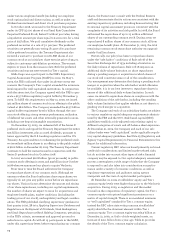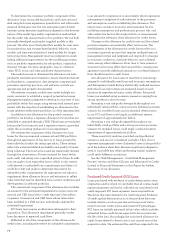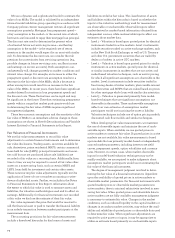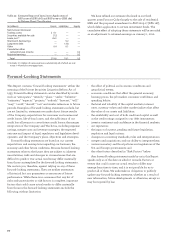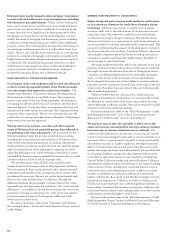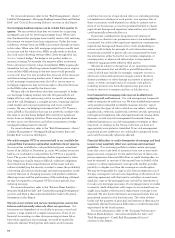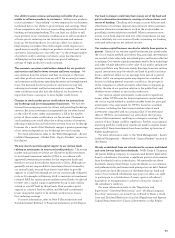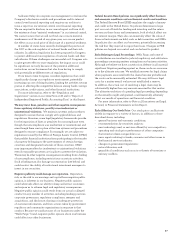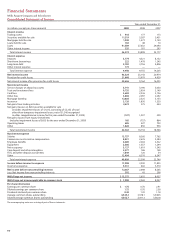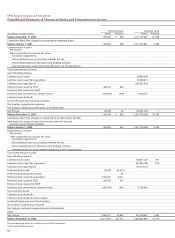Wells Fargo 2009 Annual Report Download - page 84
Download and view the complete annual report
Please find page 84 of the 2009 Wells Fargo annual report below. You can navigate through the pages in the report by either clicking on the pages listed below, or by using the keyword search tool below to find specific information within the annual report.
Bankruptcy laws may be changed to allow mortgage “cram-downs,”
or court-ordered modifications to our mortgage loans including
the reduction of principal balances. Under current bankruptcy
laws, courts cannot force a modification of mortgage and home
equity loans secured by primary residences. In response to the
current financial crisis, legislation has been proposed to allow
mortgage loan “cram-downs,” which would empower courts to
modify the terms of mortgage and home equity loans including
a reduction in the principal amount to reflect lower underlying
property values. This could result in writing down the balance of
our mortgage and home equity loans to reflect their lower loan
values. There is also risk that home equity loans in a second lien
position (i.e., behind a mortgage) could experience significantly
higher losses to the extent they become unsecured as a result of
a cram-down. The availability of principal reductions or other
modifications to mortgage loan terms could make bankruptcy
a more attractive option for troubled borrowers, leading to
increased bankruptcy filings and accelerated defaults.
RISKS RELATING TO THE WACHOVIA MERGER
Our financial results and condition could be adversely affected if
we fail to realize the expected benefits of the Wachovia merger
or it takes longer than expected to realize those benefits. The
merger with Wachovia Corporation requires the integration of
the businesses of Wachovia and Wells Fargo. The integration
process may result in the loss of key employees, the disruption
of ongoing businesses and the loss of customers and their busi-
ness and deposits. It may also divert management attention and
resources from other operations and limit the Company’s ability
to pursue other acquisitions. There is no assurance that we will
realize the cost savings and other financial benefits of the merger
when and in the amounts expected.
We may incur losses on loans, securities and other acquired
assets of Wachovia that are materially greater than reflected in
our preliminary fair value adjustments. We accounted for the
Wachovia merger under the purchase method of accounting,
recording the acquired assets and liabilities of Wachovia at fair
value based on preliminary purchase accounting adjustments.
Under purchase accounting, we had until one year after the merger
date to finalize the fair value adjustments, meaning we could
adjust the preliminary fair value estimates of Wachovia’s assets
and liabilities based on new or updated information that provided
a better estimate of the fair value at merger date.
We recorded at fair value all PCI loans acquired in the
merger based on the present value of their expected cash flows.
We estimated cash flows using internal credit, interest rate and
prepayment risk models using assumptions about matters that
are inherently uncertain. We may not realize the estimated cash
flows or fair value of these loans. In addition, although the
difference between the pre-merger carrying value of the credit-
impaired loans and their expected cash flows— the “nonaccretable
difference”—is available to absorb future charge-offs, we may be
required to increase our allowance for credit losses and related
provision expense because of subsequent additional credit
deterioration in these loans.
For more information, refer to the “Overview” and “Critical
Accounting Policies – Purchased Credit-Impaired Loans” sections
in this Report.
GENERAL RISKS RELATING TO OUR BUSINESS
Higher charge-offs and worsening credit conditions could require
us to increase our allowance for credit losses through a charge
to earnings. When we loan money or commit to loan money
we incur credit risk, or the risk of losses if our borrowers do not
repay their loans. We reserve for credit losses by establishing
an allowance through a charge to earnings. The amount of this
allowance is based on our assessment of credit losses inherent in
our loan portfolio (including unfunded credit commitments). The
process for determining the amount of the allowance is critical to
our financial results and condition. It requires difficult, subjective
and complex judgments about the future, including forecasts of
economic or market conditions that might impair the ability of
our borrowers to repay their loans.
We might underestimate the credit losses inherent in our loan
portfolio and have credit losses in excess of the amount reserved.
We might increase the allowance because of changing economic
conditions, including falling home prices and higher unemploy-
ment, or other factors such as changes in borrower behavior.
As an example, borrowers may be less likely to continue making
payments on their real estate-secured loans if the value of the real
estate is less than what they owe, even if they are still financially
able to make the payments.
While we believe that our allowance for credit losses was
adequate at December 31, 2009, there is no assurance that it will
be sufficient to cover future credit losses, especially if housing
and employment conditions worsen. We may be required to build
reserves in 2010, thus reducing earnings.
For more information, refer to the “Risk Management – Credit
Risk Management Process” and “Critical Accounting Policies –
Allowance for Credit Losses” sections in this Report.
We may have more credit risk and higher credit losses to the
extent our loans are concentrated by loan type, industry segment,
borrower type, or location of the borrower or collateral. Our
credit risk and credit losses can increase if our loans are concen-
trated to borrowers engaged in the same or similar activities or to
borrowers who as a group may be uniquely or disproportionately
affected by economic or market conditions. We experienced the
effect of concentration risk in 2008 and 2009 when we incurred
greater than expected losses in our Home Equity loan portfolio due
to a housing slowdown and greater than expected deterioration
in residential real estate values in many markets, including the
Central Valley California market and several Southern California
metropolitan statistical areas. As California is our largest banking
state in terms of loans and deposits, continued deterioration in
real estate values and underlying economic conditions in those
markets or elsewhere in California could result in materially
higher credit losses. As a result of the Wachovia merger, we have
increased our exposure to California, as well as to Arizona and
Florida, two states that have also suffered significant declines in
home values. Continued deterioration in housing conditions and
real estate values in these states and generally across the country
could result in materially higher credit losses.
For more information, refer to the “Risk Management – Credit
Risk Management Process” section and Note 6 (Loans and Allowance
for Credit Losses) to Financial Statements in this Report.


